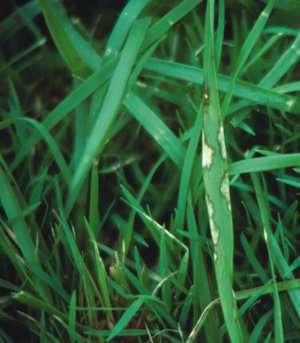G1909
Brown Patch Disease of Turfgrass
Causes, symptoms and management of brown patch disease in turfgrass. This is one in a series of NebGuides on managing turfgrass diseases.
- Introduction
- Cause, Hosts, and Occurrence
- Key Symptoms
- Recommended Cultural/Maintenance Practices
- Fungicide Program
|
Introduction
Brown patch is a common disease found mostly in tall fescue although it can affect all types of turf. Cultural practices are the first line of defense in managing brown patch; however, fungicides also effectively control this disease. The following information describes the disease and how to identify and manage it.
Cause, Hosts, and Occurrence
Cause: Rhizoctonia solani
Principal hosts: Ryegrasses, tall fescue, creeping bentgrass, Kentucky bluegrass
Occurrence: July – September
Key Symptoms
Tall-cut turf: Roughly circular patches of blighted grass with a reddish-tan color. Long, irregularly shaped leaf lesions surrounded by a dark brown margin (Figure 1).
Greens and fairway height: Diffuse, roughly circular, reddish brown patches up to 2 feet in diameter. Patches may have a smokey-gray outer ring.
Recommended Cultural/Maintenance Practices
- Avoid high nitrogen fertilizer applications during the summer. Feed turf with low rates of nitrogen to maintain moderate growth and good recovery from disease.
- Perform maintenance to improve air circulation across the turf.
- Avoid night irrigations.
- Reseed or overseed with turf species with higher tolerance.
Fungicide Program
Golf Courses: On bentgrass greens use the most effective products from early July through mid-August. Curative treatments should include a strobilurin or carboxamid product.
Home Lawn and Other Turfs: Use high label rates of propiconazole or thiophanate methyl to provide three to four weeks of protection. Treat areas prone to brown patch with a preventative when night temperatures are going to be above 75°F; other areas can be treated curatively as needed.
Fungicides for brown patch management are presented in Table I. An example product is listed for each active ingredient; other products also may be available. Homeowner and commercial product labels will list active ingredients. While the active ingredient may be in combination with others, users should look for a specific active ingredient with or without other chemistry modes of action.
| Table I. Fungicides for brown patch control in turf1 | ||||
| Fungicide | Fungicide Class | Application Interval (days) |
Efficacy2 |
Product |
| Azoxystrobin | Strobilurin | 14-28 |
4/3 |
Heritage |
| Captan | Phthalimide | 7-10 |
L |
Captan |
| Chloroneb | AH4 | 10 |
L |
Terraneb SP |
| Chlorothalonil | Chloronitrile | 7-14 |
3 |
Daconil Ultrex3 |
| Copper hydroxide + mancozeb | Inorganic + dithiocarbamate | 7-14 |
L |
Junction |
| Fenarimol | DMI4 | 7-14 |
2 |
Rubigan |
| Fludioxonil | Phenylpyrroles | 7 |
3+ |
Medallion |
| Fluoxastrobin | Strobilurin | 14-28 |
3+ |
Disarm |
| Flutolanil | Carboxamide | 14-21 |
3+ |
Prostar |
| Hydrogen dioxide | 7 |
1 |
Zerotol | |
| Iprodione | Dicarboxamide | 14-28 |
3 |
Chipco 260193 |
| Mancozeb | Dithiocarbamate | 7 |
3 |
Fore3 |
| Myclobutanil | DMI | 10-21 |
2+ |
Eagle |
| PCNB | AH | 7-10 |
2 |
Cleary’s PCNB3 |
| Polyoxin D | Polyoxin | 7-14 |
3+ |
Endorse |
| Propiconazole | DMI | 10-21 |
2+ |
Banner MAXX3 |
| Pyraclostrobin | Strobilurin | 14-28 |
4 |
Insignia |
| Thiophanate-methyl | MBC4 | 10-14 |
2+ |
Cleary’s 33363 |
| Thiram | Dithiocarbamate | 7-10 |
2 |
Spotrete3 |
| Triadimefon | DMI | 14-30 |
2 |
Bayleton3 |
| Trifloxystrobin | Strobilurin | 14-21 |
4 |
Compass |
| Triticonazole | DMI | 14-28 |
3 |
Trinity |
| Vinclozolin | Dicarboxamide | 14-28 |
1 |
Curalan3 |
| 1Fungicide active ingredients, class and efficacy ratings for products labeled for the control of brown patch. Table adapted from Chemical Control of Turfgrass Diseases 2008, P. Vincelli and A.J. Powell, University of Kentucky Cooperative Extension Service. 2Rating system: 4 = excellent control; 3 = good to excellent control; 2 = fair to good control; 1 = control is inconsistent but good in some instances; + = intermediate between two efficacy ratings; L = limited data. 3Other products with the same active ingredient may be available. 4DMI = demethylation inhibitor (triazole fungicide) AH = aromatic hydrocarbon MBC = methyl benzimidazole carbamate |
||||
This publication has been peer reviewed.
Disclaimer Fungicides listed represent the best information available. No criticism is intended of products not listed, nor is endorsement by the University of Nebraska–Lincoln given to those listed. Read and follow all product label directions for mixing and application. |
Visit the University of Nebraska–Lincoln Extension Publications Web site for more publications.
Index: Plant Diseases
Turf
Issued February 2009
